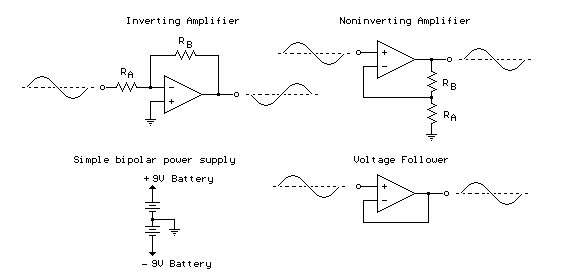

You can average with a lowpass filter or take many measurements with your ADC to remove the noise, but if that takes too long, then you need a lower noise opamp.Because it is able to function in so many diverse ways, the op-amp can be the defining element in electronic circuits of any complexity. If the opamp only has a 5V power supply then it will clip, so that won't work.Īnother issue is noise, which can obscure the signal. Offset can be a problem for another reason: if the circuit has a lot of gain (say, 10000) and the opamp has an offset of 1mV, then it will output 10V. You can also trim the offset with a circuit that shifts the input voltage, and in this case the important spec becomes drift versus temperature. If you can switch the voltage to be measured on and off, and you use an ADC after the opamp, you can also measure the offset without signal, then turn on the signal, measure again, and substract, which removes the offset. This is only a problem if the signal is DC: a bit of DC offset doesn't change the peak to peak or RMS value of an AC signal, it just shifts the whole signal. Input offset voltage can add a significant error to the small voltage you're trying to measure. Without thinking too much, one can guess that the noise at 1 Hz will be about \$\sqrt\$ times higher, so this will lead to the base precision of about 174 nV, for integration times that are at least a few seconds long. For the LM358, I could only find a plot down to 10 Hz: The noise discussed above is dynamic and cannot be simply removed in software.

#Op amp offset correction software
These are static offsets, that you can easily compensate in software unless you let them saturate the opamp due to ultra gains of 1000 or something. The input offset voltage and current is inconsequential in my opinion. zero-drift opamps.Īlternatively, you can do AC voltage measurements, but I will not go into this as your question doesn't suggest you can modulate the source easily. So what you should be looking for is opamps with low 1/f voltage noise, e.g. It has very low wideband noise, but due to 1/f noise, it is impossible to make a DC voltage measurement, more precise than 6 nV, regardless of how long you integrate.ĭue to 1/f noise the precision has a lower bound. In this case the base precision is given by the point where the 1/f slope of input voltage noise density crosses 1 Hz. As you speak about nanovolt measurements I assume you have a low source impedance and current noise is inconsequential. However, it is not possible to just integrate arbitrarily long to attain arbitrary precision.

When you know SNR you can calculate the necessary integration time needed to discern a certain voltage step. Instead there are various noise sources at play, which will be given in datasheets.You weigh those against your signal magnitude to obtain a signal-to-noise ratio (SNR).

If the answer is no, then which parameter indicates the minimum voltage? So we know if this op-amp is good to use in the μV or even nV range? But the question is, does the output change when we change the 1.007000 V to 1.007001 V? Also, in some op-amps, the offset voltage is "nullable". If the answer is yes, the LM358 datasheet mentions a Vio of 7 mV maximum this means that, for example, a differential voltage of 1 V and 1.007 V should be amplified. The input offset voltage is defined as the voltage that must beĪpplied between the two input terminals of the op amp to obtain zero I think that aforementioned parameter which I call "sensitivity" should be Vio (input offset voltage), because it's the minimum differential voltage that can make the output non-zero, and hence, amplify it.Īccording to this document from TI it is defined as: I'm a newbie trying to measure μV-range voltages using cheap op-amps, with some software calibrations or error corrections, for education and practice.Īt first, I looked at some op-amp datasheets and looked for parameters with their unit defined as "mV" or "V", because I thought it should be indicated as volts, but didn't find anything which I could relate except Vio.


 0 kommentar(er)
0 kommentar(er)
